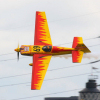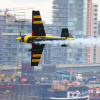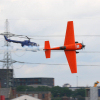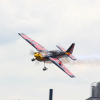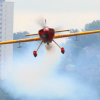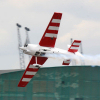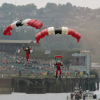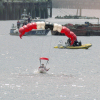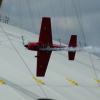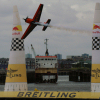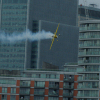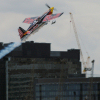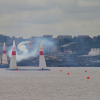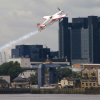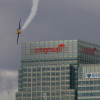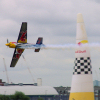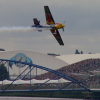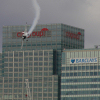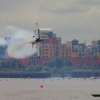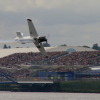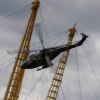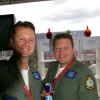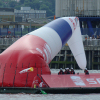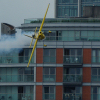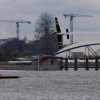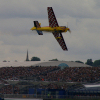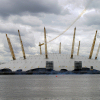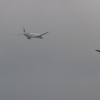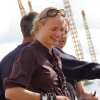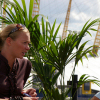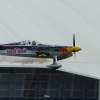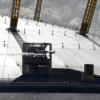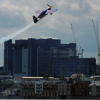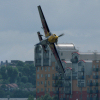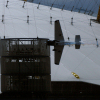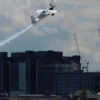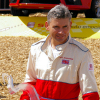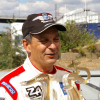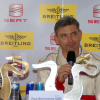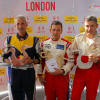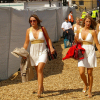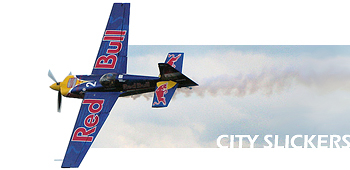
Red Bull Air Race 2007 (UK 6th Round) Review
Sunday 29th July
Round six of the Red Bull Air Race World Series came to town on the 29 July. The previous two British legs of the event held at Longleat hadn't been a total success, with the main points scoring race day even suffering cancellation due to the inclement weather in 2006. Would a change in location to the City prove to be a profitable venture? Would the Capital gain? Or would 2007's event be just as taxing on the crowds as previous races?
trod the pavements of gold to bring this report. Additional photography from .
After five rounds of the World Series, Britain's Paul Bonhomme held a two point lead in the table over American Mike Mangold. Hopes were high of a home win, especially as fellow Brits Steve Jones and Nigel Lamb would also be in contention. Bonhomme had won the previous round in Interlaken, Switzerland, round two in Rio De Janeiro, and has never been off the podium this year, so was most definitely a firm favourite on home 'turf'.
The Red Bull Air Race is competed over a race track marked out by pylons, or 'Air Gates' - 20 metre high, air filled, spinnaker and PVC material cones - between and around which the pilots must pass in a strictly controlled order and attitude. Some gates require the aircraft to pass through with the wings level, and others in a knife-edge, 90-degree, bank attitude. Also they cannot be too high or too low. Any variation from these rules results in an immediate three-second penalty, and ten seconds for damaging a pylon. With laps only lasting about one and a half minutes, errors can have serious consequences on results - or worse. Although the pylons are designed to tear easily, and not damage the aircraft, any kind of impact on a fast moving aeroplane has the potential for danger - as Steve Jones found out in the spectacular setting of Monument Valley. He was so low that he not only put a wing through a pylon, but also caught his wheel spat on one of the tie-down straps, which ripped off the spat and could so easily have pulled Steve into the valley floor. Like any motor sport, air racing has its risks, which has contributed partly to the Series' success over the few years that it has been running.
All the competitors in the Series are required to be highly experienced aerobatic pilots - Jones and Bonhomme will be familiar to airshow visitors as the Red Bull Matadors for example - which originally resulted in the teams competing in their 'stock' aerobatic aircraft such as Su26 and lower powered Extras, but this has changed and by 2007 the sport had become big money business, with highly professional teams now making use of the fastest aircraft and refining and modifying them specifically for racing in the Red Bull Series. The Series standings going into the London leg shows the first nine places taken up by Edge 540 aircraft, with a single MX2, a further 540, an Extra 300SR and 300S completing the thirteen place table. That Extra 300SR is flown by Nicolas Ivanoff, and is the most specifically designed aircraft for the air racing series. With modified wing and tail surfaces designed specifically to reduce weight and drag, to improve acceleration and cornering, and fitted with a 330 hp Lycoming and MT propeller, Ivanoff debuted the new Extra in the previous round at Interlaken with high hopes of taking top spot. Despite clocking up the fastest qualifying time, he lost his first knockout leg to eventual third place finisher Peter Besenyei. Could London see this new design come good and take the Series to new levels? Paul Bonhomme was definitely worried. He had gone into that Switzerland round assuming that Nicolas would win every remaining round, and was calculating where he would need to finish in each race to have enough points to stay in front.
The area allocated for the race on the Thames - adjacent to The O2 Arena (previously known and loved as the Millennium Dome) - was narrower than in the other locations so a new layout was required. Normally the 'Quadro' is situated near the middle of the circuit, but for the UK leg it was positioned at the southern end of the course, and the competitors would run twice through the pylons. From the first practice runs on the Thursday, it was clear that the wind would be a challenge to the pilots, reaching 21 knots at times. During qualifying on Saturday, Ivanoff's Extra was particularly affected by the conditions, prompting suggestions of a re-design to the control surfaces which just weren't up to correcting the course of the aircraft against the wind. The times clocked up would decide the starting order for the final on Sunday - and give an indication of performance. Worryingly Mike Mangold headed the list, with Bonhomme only managing third. Hopefully the Brit could turn the tables come the finals.
Sunday dawned grey, overcast, but a little less windy. Helpfully the wind direction was straight down the course rather than across. The event had been a sell out, with 35,000 race-goers making use of the thankfully modern sections of the London Underground and Docklands Light Railway to get to their seats and standing areas. The infrastructure set up by Red Bull is impressive to say the least. As well as the spectator enclosures, a Temporary Runway had been set up at the Royal Albert Dock, just to the north of London City airport, with hangers and facilities for housing the aircraft and crews. An area at the northern end of the course played host to the race control tower, the High Flyer's Lounge, the Race Club and the media centre, looking out onto the start/finish gate, through which, at just before 11:00 on Sunday, German Klaus Schrodt, in an Extra 300S, entered to kick-off the Elimination round for the Red Bull Air Race World Series Round Six.
One by one, the twelve contestants dived down past the City's high-rise offices at speeds of up to 400 km/h (250 mph), vying to be amongst the eight fastest times and to qualify for the quarterfinal knockout stages. It was an amazing sight, watching these small machines jinking around the pylons at very few feet, with the varying backdrops of this part of the Thames. As the times came in, we were happy to see Bonhomme at the top of the pile. A home win was a strong possibility. Steve Jones had taken a gate too high but just managed to squeeze through in eighth position, surprisingly just behind the current World Champion, American Kirby Chambliss. Chambliss had registered the fastest entry speed at 402.05 km/h, but a slow intermediate 2 time, plus a similar penalty to Jones had dropped him down the standings. Ivanoff finished a dismal weekend by finishing ninth, and going out. A fate he shared with regular lowly finishers Schrodt and Russian Sergey Rakhmanin. Normally better placed Austrian Hannes Arch joined them for an early bath courtesy of six penalty points.
With the teams back at the temporary airport making preparations for the next stage of the competition, a pair of aerobatic helicopters took turns at filling the time. The Blue Eagle's Lynx (which had previously dropped a team of Red Devils into the chilly looking Thames) piloted by WO1 Barry Jones, carried out its solo routine. Although we are used to the Lynx being thrown around, rolling, looping and back flipping, it's still a thrilling display and unusually exciting for a helicopter - and unique, or so I thought. In came a Bolkow 105 in Red Bull colours, an incredibly agile machine, which also manages the same manoeuvres as the Lynx, but tighter, faster and more continuously. It's really something to see. Well worthy of a bigger stage at somewhere like RIAT. Paul Stoneman WO2, the Lynx co-pilot, was impressed but quick to point out that "They're a lot lighter than we are"!
It was soon race time again, and now we were into the head-to-head knockout stages. The quicker pilot goes through, from pairings decided by the earlier round. Unfortunately this put teammates Bonhomme and Jones against each other. Jones' very respectable time was no match for Bonhomme, who put in the fastest time of the quarter final at 01:25.52. The third Brit, Nigel Lamb in the sole MX2 but normally to be seen at the controls of warbirds, fell to the Spaniard Alejandro MacLean. In the third heat 'Mr Red Bull Air Race' Peter Besenyei finished nearly six seconds ahead of Dutchman Frank Versteegh. Hungarian Besenyei is a favourite personality in the aerobatic community. Twenty-one times winner of his home country's aerobatic championship, an early entrant of the Red Bull events, third in the 2004 series, and second in both 2005 and 2006, and sprung to nationwide fame in Hungary after flying inverted underneath a suspension bridge in Budapest. The fourth heat was an all-American, all-Series Champion contest. Despite his less than impressive qualifying time, Chambliss was well capable of victory over Mangold. No cigar though. Mangold had two seconds to spare.
The Semi Finals. Despite putting in a time a lap time of over two seconds more than that of his qualifying run, the Matador Bonhomme had no trouble against the Spaniard MacLean. We had a Brit in the final. Great news, but who would he be facing? Besenyei was first to dive down out of the hold, and with another clean lap, crossed the line at 1:25.47. A very respectable time, but not enough to beat Mangold who worryingly pulled out the fastest time of the day at an incredible 1:24.79. The Final would pit the Championship leaders against each other, for a nail-biting ending. As a taster - and to fight for third place - MacLean and Besenyei tried to squeeze a little bit more from their Edges. The Hungarian squeezed the hardest, making it on to the podium to make it two wins and two third places for 2007, and strengthening his hold on third place in the Championship, ahead of Chambliss.
And then the Final. Bonhomme first. "Enter the box, and smoke on". Paul dived down in front of his home crowd, willing him to go faster. Through the gates, and flick, flick, pull. 9G, 10G. Strain against the forces of nature. Left, right, left, back through the slalom and past the Dome, pull up towards the skyscrapers and over. Back down again, and put his sweating body through the course again. 1:27.25. Not good. Not good at all, and Paul's worse time of the day. Hopefully age might work in Bonhomme's favour in such a gruelling sport. Mangold at nearly 52 has among other experiences more than 2,500 hours in the US Air Force, mostly in Phantoms including serving in Thailand, Egypt, South Korea and the Philippines. A highlight of Mike's Air Force career was earning the Outstanding Graduate Award of his Fighter Weapons School (Top Gun) Class at Nellis AFB in 1983. He now flies 767 airliners for American Airlines. He put his body through the wringer again, and somehow pulled out a winning time of 1:25.82. He'd done it. Mangold was 'Top Gun' of Red Bull London.

